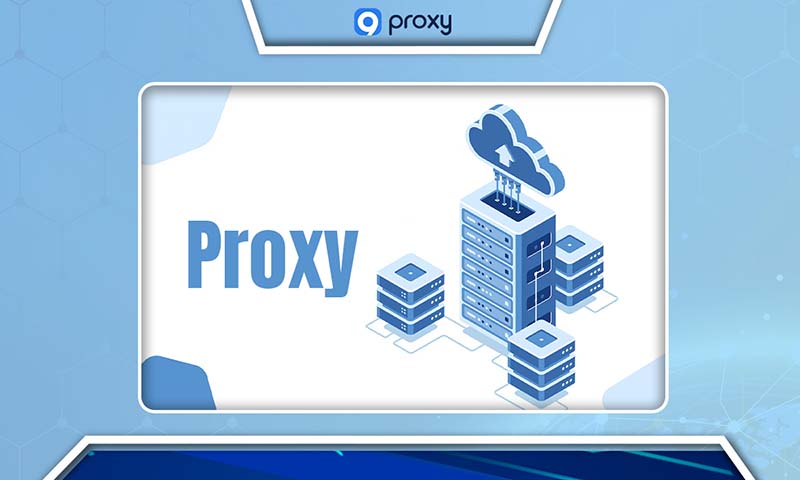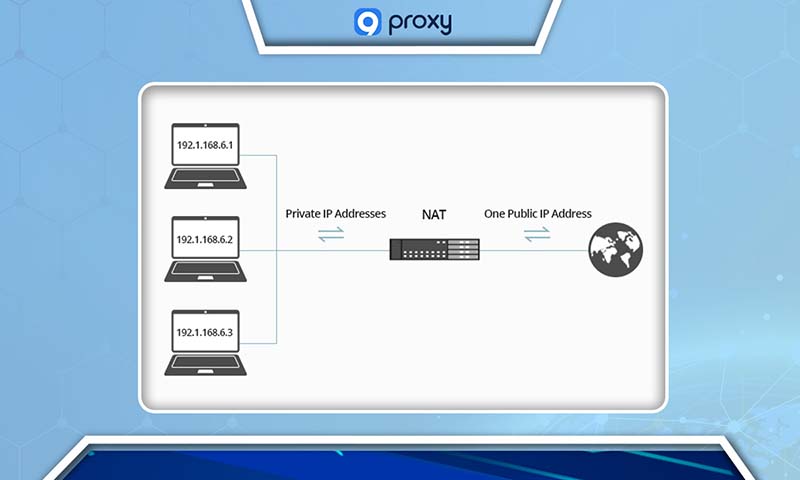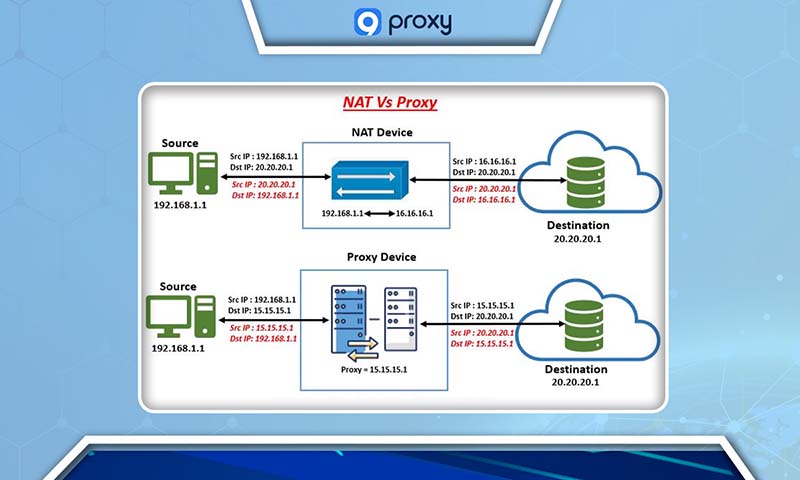Nat vs Proxy: The Main Difference Between the Two Networks
In the realm of organizational IT, ensuring a secure local area network (LAN) is crucial. Two common tools in this endeavor are proxies and Network Address Translation. Both serve to mediate and secure internet connections, but they do so in distinct ways. Below we'll explore the differences between them, encapsulated in the discussion on NAT vs proxy.
What Is a Proxy?
A proxy is essentially a server positioned between a client seeking a resource and another server from which that resource originates, serving as an intermediary. When a client makes a request, it is directed to the proxy server first. The proxy then assesses this request according to established filtering rules. If the request meets these criteria, the proxy forwards it to the target server to fetch the resource.
Alternatively, the proxy might fulfill the request using its cached data, eliminating the need to reconnect with the target server for subsequent requests. This caching capability significantly enhances performance by speeding up response times and reducing bandwidth usage. Additionally, proxies play a crucial role in network security by filtering out requests to certain websites, thereby controlling access and improving safety.

How Does Proxy Work?
Every device that connects to the internet is assigned an Internet Protocol (IP) address, which is essential for identification and communication over the network. This IP address is central to the functionality of proxy servers. Here’s a breakdown of how a typical proxy server operates:
- Request Initiation: When a device sends a request to access online resources, it goes through a proxy server. The proxy first reads and interprets this request.
- Forwarding the Request: The proxy then relays this request to the appropriate internet server, acting as a go-between for the device and the server.
- Data Transmission: The internet server, recognizing the IP address of the proxy rather than the original device, sends the requested data back to the proxy.
- Security Check: Upon receiving the data, the proxy server processes it. It checks for potential malware or security threats within the data to ensure it’s safe to pass along.
- Delivery to Device: Once deemed safe, the data is forwarded from the proxy to the original requesting device.
Benefits of Proxy
Though proxies operate on a relatively simple mechanism, they offer substantial value to IT companies and other business organizations. Here are some of the primary benefits and use cases for proxies:
- Enhanced Security: Proxies serve as a protective barrier between your systems and the internet, acting similarly to a firewall. This barrier helps prevent hackers from accessing your IP address, which they could use to infiltrate your computer or network.
- Private Browsing: Proxies enable private browsing, watching, listening, and shopping experiences by shielding your online activities. Using different proxies helps avoid excessive advertisements and the collection of IP-specific data, making your internet footprint challenging to track.
- Access to Location-specific Content: Proxies allow you to access content that may be restricted in your location by assigning a server with an IP address from another country. This makes it appear as though you are browsing from that country, thereby granting you access to region-locked content, like certain streaming services or websites.
- Control Over Internet Usage: Proxies can be configured to restrict access to websites that are not aligned with an organization's principles or are deemed distracting. For instance, companies often block access to social media platforms like Facebook to minimize distractions and maintain productivity among employees.

What Is NAT?
Network Address Translation (NAT) is a method extensively utilized by internet service providers (ISPs) and various organizations to allow multiple devices within a private network to share a single public IP address. This technique enables these devices to connect and communicate with others on a public network without each device requiring a unique IP address.
Originally devised as a temporary measure to counter the scarcity of IPv4 addresses, NAT effectively extends the life of this limited address space. By allocating one public IP to multiple devices on a local network, it helps conserve the finite number of IPv4 addresses that are publicly routable. Additionally, NAT enhances network security by masking individual IP addresses of devices within a private network behind one public IP. This obscuring of IP addresses provides an additional layer of protection, making it more challenging for external entities to directly target devices within the network.

How Does NAT Work?
NAT is a critical function carried out by a router, which acts as a bridge between two networks—often a private network and the internet. Here's what happens: When a device within a private network wants to communicate with a device on the public internet, the router steps in as the middleman. It intercepts the outgoing data from the private device and modifies it by swapping the private IP address for its own public IP address. This allows the data to travel to the public network.
Conversely, when a response comes back from the public network, the router captures this incoming data. It then performs the reverse process by substituting the public IP address back with the original private IP address before forwarding the data to the private network device. This entire process is seamless, allowing both networks to communicate without realizing the ongoing address changes.
Benefits of NAT
NAT brings a number of significant benefits such as:
- IP Address Conservation: NAT allows multiple devices to share a single IP address, which is crucial for conserving IP space. This is particularly important for organizations with limited IP addresses allocated by their Internet Service Provider (ISP).
- Enhanced Security: By obscuring the internal network from external eyes, NAT enhances security. It helps shield specific IP addresses from being targeted by external attacks and prevents direct internet access to devices on the internal network. Additionally, it can block access to harmful or unwanted online content.
- Increased Speed: NAT can boost communication speeds by reducing the packet load routed through the network. Since devices on the internal network do not each require a unique IP address, the overall network efficiency improves.
- Network Design Flexibility: NAT provides significant flexibility in how a network is structured, allowing changes to network setups without the need to alter IP addresses. This flexibility is beneficial for enhancing network security, performance, or integrating new devices.
- Multi-Homing Capabilities: Through NAT, devices within a private network can connect to several public networks—a strategy known as multi-homing. This is particularly valuable for organizations needing connections with multiple ISPs or those seeking failover solutions if one ISP fails. Multi-homing via NAT ensures greater connection redundancy and higher network uptime.
- Cost Reduction: Since NAT reduces the number of necessary IP addresses, it can lead to significant cost savings in IP address licenses and related expenses.
- Simplified Network Management: NAT simplifies the administration of networks by decreasing the number of IP addresses that need management. This is especially beneficial for organizations with extensive device networks or those looking to minimize network management workload.

What Is the Difference Between NAT and proxy?
A proxy operates as an intermediary within the seventh layer of the OSI model, specifically dealing with and forwarding requests based on content-specific protocols such as HTTP and FTP from clients to external servers. It often enhances security, ensures anonymity, and enables data caching. Setting up a proxy involves explicit configuration on the client’s system, and it is commonly positioned in a Demilitarized Zone (DMZ) within corporate networks.
On the other hand, Network Address Translation (NAT) functions at the third and fourth layers, focusing on the management of IP addresses. It translates private IP addresses into a public one for outbound traffic, simplifying connectivity without requiring adjustments to specific applications by the user. NAT solutions are generally more cost-effective and are integrated into network edge devices like routers or firewalls. While NAT provides fundamental traffic control and optimizes the use of public IP addresses, it does not support protocol-specific functions or offer the advanced security features that proxies provide.
Note: When selecting between a proxy and NAT, consider your specific needs for security and protocol support. Proxies are ideal for scenarios requiring detailed access control and enhanced privacy, whereas NAT is suitable for basic IP address management and network simplicity.

FAQ
In what scenarios should I use NAT over a proxy?
Opt for Network Address Translation (NAT) when your main requirement is to allow numerous devices to access the internet through a single public IP address. This is particularly applicable in home environments or smaller organizations where complex traffic inspection or content filtering isn't necessary.
How do NAT and proxies affect the performance and speed of a network?
NAT usually has a slight impact on network performance and is mostly noticeable in specific scenarios such as when setting up port forwarding. On the other hand, proxies can reduce network speed due to the extra data processing they perform, particularly when involved in content filtering or conducting user authentication.
Which is better for handling encrypted traffic: NAT or a proxy?
Proxies are more adept at managing encrypted traffic, especially those set up to handle SSL traffic. They have the capability to inspect and filter SSL data, a function that NAT does not naturally perform without undergoing specific configurations.
Conclusion
Proxy servers and Network Address Translation (NAT) are often used for similar purposes but operate differently. In the discussion of Nat vs proxy shows us that, NAT functions at a more basic level compared to standard proxy systems. Proxy servers typically support specific application layer protocols, making them protocol-specific.
A proxy server acts by connecting to the internet, responding to, and receiving traffic on behalf of a client machine. In contrast, a NAT device modifies the source address of the incoming traffic before routing it to the internet.
Get Newsletters About Everything Proxy-Related